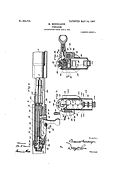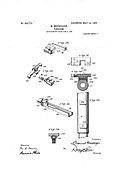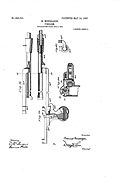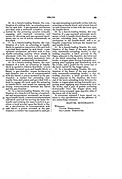Pengguna:Gladius Oceanus/Beginner
| Training | Beginner | Public | Expert | Clan |
Senapan Mondragón mengacu pada dua desain senapan yang dikembangkan oleh Jenderal Manuel Mondragón. Desain senapan ini meliputi model senapan aksi-grendel M1893 dan M1894, serta senapan semi-otomatis M1908 yang merupakan senapan pertama yang digunakan untuk pertempuran. The Mondragón rifle refers to one of two rifle designs developed by Mexican artillery officer General Manuel Mondragón. These designs include the straight-pull bolt-action M1893 and M1894 rifles, and Mexico's first self-loading rifle, the M1908 - the first of the designs to see combat use. Senapan aksi-grendel tarik-lurus[sunting | sunting sumber]Mondragón mulai mengerjakan desain senapan pertamanya di tahun 1891. Selama tinggal di Belgia, ia mengajukan permohonan paten yang ditermanya pada 23 Maret 1892. Mondragón lalu diberikan paten pada 20 April 1892 dari Kantor Paten Prancis. Ia juga mengajukan paten untuk desainnya ke Kantor Paten Amerika Serikat pada 8 Februari 1893, yang diberikan pada 24 Maret 1896.[1] The rifle, referred to as model M1893, was of a straight-pull, bolt-action design, chambered in the 6.5x48mm cartridge (also developed by Mondragón), with a fixed magazine which held an 8-round en-bloc clip.[2] The bolt was locked by two pairs of six small radially-arranged lugs (reminiscent of, e. g., AR-15) locking in helical grooves in the receiver.[3] The rifle operated with three settings:[4] "A" (safe), "L" (normal operation), and "R" (rapid). The "automatic" fire setting allowed the rifle to fire a cartridge each time the bolt was manually cycled to closed position,[1] in similar fashion to Winchester M1897 pump-action shotgun. The rifle could be equipped with a knife bayonet, measuring 41 sentimeter (16 in) and 575 gram (1,268 pon), or a blade-type bayonet of 28 sentimeter (11 in) length.[5] At the time of the rifle's design, Mexico did not have any manufacturers capable of producing them to the required tolerances. Mondragón, with the backing of Diaz, subsequently entrusted the Swiss Industrial Company (Schweizerische Industrie Gesellschaft) of Neuhausen, Switzerland with the production of the rifles. SIG received the first order for 50 rifles in 1893, and a second order for 200 rifles followed in 1894. The rifles from the second order were chambered in the 5.2 × 68mm round developed by Swiss colonel Eduard Rubin, and were referred to as the model M1894 (to differentiate them from the versions chambered in the 6.5mm cartridge).[6] Senapan isi-otomatis[sunting | sunting sumber]> Mondragón melanjutkan pekerjaannya dan pada 8 Agustus 1904 dia mengajukan permohonan paten (No. 219.989) untuk desain barunya untuk senapan isi-otomatis. Paten (No. 853.715) diberikan pada tanggal 14 Mei 1907. Mondragón continued his work, and on August 8, 1904 he filed a patent application (No. 219,989) for his new design for a self-loading rifle. The Patent (No. 853,715) was granted on May 14, 1907.[7] > Desainnya diadopsi oleh Tentara Meksiko pada tahun1908 sebagai Fusil Porfirio Díaz Sistema Mondragón Modelo 1908. Di tahun yang sama, pemerintah Meksiko mengontrak SIG untuk memproduksi 4.000 pucuk senapan M1908 dengan muatan peluru 7x57mm Mauser.,Pada saat Revolusi Meksiko, hanya 400 pucuk senapan di tahin 1910 yang diterima oleh SIG. Ketidakmampuan senapan untuk mengatasi rendahnya kualitas amunisi yang tersedia pada saat itu, bersama dengan tingginya biaya SFr160 per senapan, menyebabkan pembatalan pesanan oleh pemerintah Meksiko. The design was adopted by the Mexican Army in 1908 as the Fusil Porfirio Díaz Sistema Mondragón Modelo 1908. The same year, the Mexican government contracted with SIG for the production of 4,000 M1908 rifles, chambered in the 7×57mm Mauser Mexican service cartridge. Due to the Mexican Revolution, by 1910 only 400 rifles had been delivered by SIG. The rifle's inability to cope with the poor quality of ammunition available at the time, along with the high unit cost of SFr160 per rifle, led to the cancellation of the order by the Mexican government. > The Mondragón Modelo 1908 was a gas-operated rifle with a rotating bolt using a cylinder and piston arrangement, a design considered unusual at the time. The bolt and the locking lugs was very similar to the bolt-action rifle. A switch, located on the charging handle, would disengage the bolt from the gas system, allowing the firearm to effectively operate as a straight-pull bolt-action rifle. The Mondragón Modelo 1908 rifles were fitted with a bipod. In addition to the knife bayonet introduced with the previous rifles, Mondragón designed a spade bayonet for use with the Modelo 1908,[8] for which he filed a patent application (No. 631,283) on June 6, 1911.[9] Use during World War I[sunting | sunting sumber] In 1914 the German Empire bought the remainder of the M1908 model rifles produced by SIG[10] (as many as 4000 units, depending on the total SIG production for their Mexican contract). The Germans tried to modify the rifles to chamber the 7.9×57mm S-Patrone, the service cartridge of Germany until the end of World War II), but their attempts were unsuccessful.[11] The rifles were tested by the German Army, but they proved highly susceptible to fouling caused by mud and dirt in the trenches, a common problem even with less complex designs such as the Canadian Ross Mk III straight-pull bolt-action rifle.[12] The Imperial German Flying Corps (Luftstreitkräfte) decided to adopt the rifle, where operating conditions lessened the chances of the action being fouled by mud, and issued two rifles to each aircraft's crew. The M1903 proved to be a significant improvement over the bolt-action Gewehr 98 rifles and Parabellum-Pistole pistols usually issued to crews. The M1908 rifle was re-designated as the Fl.-S.-K. 15 (Flieger-Selbstladekarabiner, Modell 1915 - Aviator's Selfloading Carbine, Model 1915) and was issued with 30-round drum magazines.[10] The drum magazine issued with the Fl.-S.-K. 15 was that designed and patented by Friedrich Blum,[13][14] with a later 32-round version of the drum magazine (Trommelmagazin 08) that had been designed for the 1913 Parabellum-Pistole (LP 08). The corps used the Mondragón rifle until a sufficient number of machine guns equipped with a synchronization gear became available, after which the M1908 was phased out of service and given to the navy. Very few of the Mondragón rifles survived the war,[10] although almost all of the rifles were still in use by the Imperial German Navy when the First World War ended. The usage of the Mondragón in the German Imperial Navy would involve destroyer crews and Seabattlions Pioneers being entirely issued Mondragón and pistol carbines[15] In Switzerland, the Mondragón self-loading rifle was modified to use the 7.5×55mm Swiss cartridge, came equipped with a 12-round magazine and a Hülsenfangkorb (a device to collect the ejected cartridges). The Mondragón rifle was also briefly installed in the World War I era two-seater aircraft, the Häfeli DH and the Blériot, however it was soon replaced by fully automatic weapons. Additional notes[sunting | sunting sumber]A few of the Mondragón rifles may have been used by Mexican soldiers during an ambush on Pancho Villa.[16] Although some sources claim that the Mexican Army had used the rifle since 1911,[17][18] two pictures from Crónica Ilustrada Revolución Mexicana, Volume 1 on pages 100[19] and 159 [20] and an article from Guns magazine[21] suggest that the rifle was in service as early as 1910. Rifle scheme and operating procedure[sunting | sunting sumber]See also[sunting | sunting sumber]References[sunting | sunting sumber]
External links[sunting | sunting sumber] | ||||||||||||||||||||||||||||||||||||||||||||||||||
 Proyek A119, juga dikenal sebagai A Study of Lunar Research Flights adalah rencana rahasia yang dikembangkan pada tahun 1958 oleh Angkatan Udara Amerika Serikat. Tujuan dari proyek ini adalah meledakkan bom nuklir di permukaan Bulan yang akan membantu menjawab berbagai misteri dalam ilmu astronomi dan astrogeologi. Bila bomnya diledakkan di atas permukaannya dan bukan di kawahnya, cahaya ledakannya dapat dengan jelas terlihat dari Bumi dengan mata telanjang. Proyek ini dimaksudkan sebagai unjuk kekuatan Amerika Serikat terhadap Uni Soviet yang lebih dulu memimpin Perlombaan Antariksa. Proyeknya tidak pernah dilaksanakan dan akhirnya dibatalkan setelah "perwira Angkatan Udara melihat besarnya resiko daripada manfaatnya" dan juga karena pendaratan di Bulan sudah cukup menjadi pencapaian yang populer di mata Amerika dan dunia. Bila proyek ini dilaksanakan, maka rencana tersebut berpotensi terjadinya miiterisasi ruang angkasa. Proyek yang mirip dibuat oleh Uni Soviet (Proyek E-4) juga tidak pernah membuahkan hasil. Keberadaan proyek AS ini terungkap pada tahun 2000 oleh Leonard Reiffel yang memimpin proyek ini pada tahun 1958. Carl Sagan pada saat itu merupakan anggota tim yang bertanggung jawab untuk memprediksi efek ledakan nuklir di dalam ruang hampa dan bergravitasi rendah. Ia juga mengevaluasi nilai ilmiah pada proyek tersebut. Dokumen aslinya dirahasiakan selama hampir 45 tahun dan terlepas dari pengungkapan oleh Reiffel, pemerintah Amerika Serikat tidak pernah secara resmi mengakui keterlibatannya dalam penelitian tersebut. Latar belakang[sunting | sunting sumber]During the Cold War, the Soviet Union took the lead in the Space Race with the launch of Sputnik 1 on 4 October 1957. Sputnik was the first artificial satellite in orbit around the Earth, and the surprise of its successful launch, compounded by the resounding failure of Project Vanguard to launch an American satellite after two attempts, had been dubbed the "Sputnik crisis" by the media and was the impetus for the beginning of the Space Race. Trying to reclaim lost ground, the United States embarked on a series of new studies and projects, which eventually included the launch of Explorer 1, the creation of the Defense Advanced Research Projects Agency (DARPA), and NASA.[1][2] Pada masa Perang Dingin, Uni Soviet memimpin Perlombaan Antariksa dengan meluncurkan satelit Sputnik 1 pada 4 Oktober 1957. Sputnik merupakan satelit buatan pertama yang sukses mengorbit Bumi. Project[sunting | sunting sumber]In 1949, the Armour Research Foundation (ARF), based at the Illinois Institute of Technology, began studying the effects of nuclear explosions on the environment. Those studies continued until 1962.[3] In May 1958, ARF began covertly researching the potential consequences of a nuclear explosion on the Moon. The main objective of the program, running under the auspices of the United States Air Force which had initially proposed it, was to cause a nuclear explosion that would be visible from Earth. It was hoped that such a display would boost the morale of the American people.[4] At the time of the project's conception, newspapers were reporting a rumor that the Soviet Union was planning to detonate a hydrogen bomb on the Moon. According to press reports in late 1957, an anonymous source had divulged to a United States Secret Service agent that the Soviets planned to commemorate the anniversary of the October Revolution by causing a nuclear explosion on the Moon to coincide with a lunar eclipse on 7 November. News reports of the rumored launch included mention of targeting the dark side of the terminator—Project A119 would also consider this boundary as the target for an explosion. It was also reported that a failure to hit the Moon would likely result in the missile returning to Earth.[5] A similar idea had been put forward by Edward Teller, the "father of the H-bomb", who, in February 1957, proposed the detonation of nuclear devices both on and some distance from the lunar surface to analyze the effects of the explosion.[6] Research[sunting | sunting sumber] A ten-member team, led by Leonard Reiffel, was assembled at the Illinois Institute of Technology in Chicago to study the potential visibility of the explosion, the benefits to science, and the implications for the lunar surface. Among the members of the research team were astronomer Gerard Kuiper and his doctoral student Carl Sagan. Sagan was responsible for the mathematical projection of the expansion of a dust cloud in space around the Moon, an essential element in determining its visibility from Earth.[4][6][7] Scientists initially considered using a hydrogen bomb for the project, but the United States Air Force vetoed that idea due to the weight of such a device, because it would be too heavy to be propelled by the missile which would have been used.[8] It was then decided to use a W25 warhead, a small, lightweight warhead with a relatively low 1.7 kiloton yield.[6] By contrast, the Little Boy bomb dropped on the Japanese city of Hiroshima in 1945 had a yield of 13–18 kilotons.[9] The W25 would be carried by a rocket toward the shadowed side of the Moon where it would detonate on impact. The dust cloud resulting from the explosion would be lit by the Sun and therefore visible from Earth.[6][7] According to Reiffel, the Air Force's progress in the development of intercontinental ballistic missiles would have made such a launch feasible by 1959.[10] Cancellation[sunting | sunting sumber]The project was canceled by the Air Force in January 1959, seemingly out of fear of the risk to the population if anything went wrong with the launch. Another factor, cited by project leader Leonard Reiffel, was the possible problem of nuclear fallout which would affect future lunar research projects and Moon colonization.[8][10] Evidence of the Soviet project[sunting | sunting sumber]Later reports in the 2010s showed that a corresponding Soviet project did indeed exist, although the only official documents on the project found so far began in 1958,[11] not the 1957 date of the "anonymous" source whose rumors initiated the US project. The official Soviet plan also differs from the scenario reported in the press. Started in January 1958, it was part of a series of proposals under the codename "E". Project E-1 entailed plans to reach the Moon, while projects E-2 and E-3 involved sending a probe around the far side of the Moon to take a series of photographs of its surface. The final stage of the project, E-4, was to be a nuclear strike on the Moon, as a display of force. As with the American plan, the E series of projects was canceled while still in its planning stages, due to concerns regarding the safety and reliability of the launch vehicle.[12][13] Consequences[sunting | sunting sumber]The signing of the Partial Nuclear Test Ban Treaty in 1963 and the Outer Space Treaty in 1967 prevented future investigation of the concept of detonating a nuclear device on the Moon. By that time, both the United States and the Soviet Union had performed several high-altitude nuclear explosions, including the American Operation Hardtack I, Operation Argus, Operation Fishbowl, and the Soviet Project K.[6] By 1969, the United States had achieved a clear victory in the Space Race with the success of the Apollo 11 Moon mission.[14] In December of that year, Apollo scientist Gary Latham suggested detonating a "smallish" nuclear device on the Moon in order to facilitate research into its geological make-up.[15] The idea was dismissed because it would interfere with plans to measure the Moon's natural background radiation.[16] The existence of Project A119 remained largely secret until the mid-1990s, when writer Keay Davidson discovered the story while researching the life of Carl Sagan for a biography. Sagan's involvement with the project was apparent from his application for an academic scholarship at the Miller Institute of the University of California, Berkeley, in 1959. In the application, Sagan gave details of the project research, which Davidson felt constituted a violation of national security.[17] The leak consisted of Sagan revealing the titles of two classified papers from the A119 project — the 1958 paper Possible Contribution of Lunar Nuclear Weapons Detonations to the Solution of Some Problems in Planetary Astronomy, and the 1959 paper Radiological Contamination of the Moon by Nuclear Weapons Detonations.[3] A 1958 paper titled Cosmic Radiation and Lunar Radioactivity, credited to I. Filosofo, was also named by Sagan in a 1961 paper written for the United States National Research Council.[18] These were among the eight reports created by the project, all of which were destroyed in 1987.[4] The resulting biography, Carl Sagan: A Life, was published in 1999. Shortly after, a review published in Nature highlighted the discovery of the leaked information.[19] That led Reiffel to break his anonymity and write a letter to the journal confirming that Sagan's activity had at the time been considered a breach of the confidentiality of the project. Reiffel took the opportunity to reveal details of the studies, and his statements were widely reported in the media.[7][20] Reiffel's revelation of the project was accompanied by his denunciation of the work carried out, with the scientist noting that he was "horrified that such a gesture to sway public opinion was ever considered".[4] As a result of the publicity the correspondence created, a freedom of information request was lodged concerning Project A119. It was only then that A Study of Lunar Research Flights – Volume I was made public, over 40 years after its inception.[21] A search for the other volumes of documentation revealed that other reports were destroyed in the 1980s by the Illinois Institute of Technology.[6] David Lowry, a nuclear historian from the United Kingdom, has called the project's proposals "obscene", adding, "had they gone ahead, we would never have had the romantic image of Neil Armstrong taking 'one giant leap for mankind'".[4] See also[sunting | sunting sumber]
Footnotes[sunting | sunting sumber]
References[sunting | sunting sumber]
|
Story[sunting | sunting sumber]Templat:More plot Action Taimanin takes place in an alternate near future Japan. Demons have crossed over from the dark side, breaking the unspoken rules of non-interference. The rule is now obsolete, and a war rages between the humans and demons. As the fight rages on, crime syndicates are taking advantage of the chaos to rise in power. The government established an organization of ninja called "Taimanins" to fight the demons.[4] The game's first storyline finished with chapter 16, part 2[5] with the extended storyline now on chapter 19. Gameplay[sunting | sunting sumber]Action Taimanin features multiple game modes. The main quest begins with retrieving a stolen bio-weapon from a UFS base. Time Attack mode has players racing against the clock and other players to try and rank as high as possible. Special Mode is a vehicle race to avoid obstacles and get to the finish line. By completing different modes and training, players can unlock additional outfits for their favorite characters. Support characters are also on hand to help out with various skills. Bonding with the support characters will, unlock special slice-of-life events.[4] Characters[sunting | sunting sumber]In Action Taimanin, the player takes the role of Fuuma Kotarou (ふうま 小太郎), the newly appointed captain of the Taimanin Task Force. Over the course of the game, Kotarou will recruit both playable and non-playable Task Force members. Playable characters can be obtained with in-game currency while Supporters are acquired through gacha banners. The following is a list of playable characters and does not cover the game's Supporters. Since the opening of the global server, the game adds a new playable character every 2 months.[6]
Development[sunting | sunting sumber]Action Taimanin was announced at TGS 2019 as an general audience aimed 3D game set in the Taimanin universe.[33] The starting playable characters unveiled were Igawa Asagi, Igawa Sakura, and Mizuki Yukikaze.[34] Release[sunting | sunting sumber]Shortly after the Japanese release, users noticed a remixed version of Au5's "Snowblind" was used in-game but the artist wasn't featured in the game's credits. Gremory Games would then issue an apology for copyright infringement and take measures to avoid similar situations in the future.[35] In September 2020, it was announced that Action Taimanin would be released globally for PC on Steam, as well as on iOS and Android devices.[36] On May 4, 2021, the Japanese and global server merged with the former folding into the latter. The Japanese server final closure took place on July 27, with urging of Lilith and Gremory for Japanese players to register for a transfer.[37] The global server celebrated its first anniversary with several in-game events lasting for all of October 2021[38] with a second anniversary event taking place October 2022.[29] Reception to the second anniversary was negative due to Gremory Games introducing the first paid-only character, Annerose from Koutetsu no Majo Annerose, without prior notice after she won the game's 2022 character popularity poll.[39] Reception[sunting | sunting sumber]Sequential Planet complimented the game's visuals and performance as well as it being F2P-friendly. However, they criticized the stamina system, combat, and enemy variety.[40] Iyane Agossah from DualShockers included Action Taimanin in his top 10 games of 2020, praising the game's story and calling it "surprisingly good and researched". However, he criticized the aggressive monetization and repetitive gameplay.[41] Game Rant called Action Taimanin one of the best free anime games on Steam.[42] See also[sunting | sunting sumber]Notes[sunting | sunting sumber]References[sunting | sunting sumber]
External links[sunting | sunting sumber] | ||||||||||||||





















